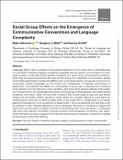Files in this item
Social group effects on the emergence of communicative conventions and language complexity
Item metadata
| dc.contributor.author | Atkinson, Mark | |
| dc.contributor.author | Mills, Gregory J | |
| dc.contributor.author | Smith, Kenny | |
| dc.date.accessioned | 2020-11-02T10:30:15Z | |
| dc.date.available | 2020-11-02T10:30:15Z | |
| dc.date.issued | 2019-01 | |
| dc.identifier | 270943679 | |
| dc.identifier | 508bd186-ba7a-4528-b46a-108bd4838321 | |
| dc.identifier | 85062836876 | |
| dc.identifier.citation | Atkinson , M , Mills , G J & Smith , K 2019 , ' Social group effects on the emergence of communicative conventions and language complexity ' , Journal of Language Evolution , vol. 4 , no. 1 , pp. 1-18 . https://doi.org/10.1093/jole/lzy010 | en |
| dc.identifier.issn | 2058-4571 | |
| dc.identifier.other | crossref: 10.1093/jole/lzy010 | |
| dc.identifier.uri | https://hdl.handle.net/10023/20878 | |
| dc.description | This project has received funding from the European Research Council (ERC) under the European Union’s Horizon 2020 research and innovation programme under grant agreement No. 681942, and a Marie Curie IOF (PIOF-GA-2009-236632-ERIS). The first author was supported by an Arts & Humanities Research Council PhD Studentship (AH/K503010/1). | en |
| dc.description.abstract | Languages differ in their complexity. One possible explanation for this observation is that differences in social factors influence linguistic complexity: languages that are used for communication in small-scale ‘societies of intimates’ exhibit greater complexity as a result of the communicative contexts in which they are typically employed. We used the techniques from referential communication studies across three experiments to assess the effects of two social group factors—group size and amount of communally shared knowledge—on the brevity and transparency of linguistic conventions. In Experiment 1, we explored the effects of a manipulation of group size, comparing the conventions which develop from the interaction of two speakers, with those which develop between three speakers. In Experiment 2, we manipulated the extent to which groups of three speakers share talk-relevant contextual information. While we found the conditions that involve larger groups and less shared background information initially resulted in longer labels and a greater reliance on more literal descriptive terms, there was no effect of either factor in the longer term. In Experiment 3, we investigated the transparency of the conventions of Experiments 1 and 2 by assessing how well they could be matched to their intended referents by naive individuals. We found no evidence to support the claims that communicative contexts involving communicating with more individuals, or individuals with whom less relevant information is shared, produce more transparent conventions. Our experiments ultimately provide no support for the idea that the structure of linguistic conventions is shaped by the groups in which they develop. | |
| dc.format.extent | 18 | |
| dc.format.extent | 858729 | |
| dc.language.iso | eng | |
| dc.relation.ispartof | Journal of Language Evolution | en |
| dc.subject | Interaction | en |
| dc.subject | Linguistic conventions | en |
| dc.subject | Language complexity | en |
| dc.subject | Social group effects | en |
| dc.subject | Esoteric communication | en |
| dc.subject | BF Psychology | en |
| dc.subject | DAS | en |
| dc.subject.lcc | BF | en |
| dc.title | Social group effects on the emergence of communicative conventions and language complexity | en |
| dc.type | Journal article | en |
| dc.contributor.institution | University of St Andrews. School of Management | en |
| dc.identifier.doi | https://doi.org/10.1093/jole/lzy010 | |
| dc.description.status | Peer reviewed | en |
This item appears in the following Collection(s)
Items in the St Andrews Research Repository are protected by copyright, with all rights reserved, unless otherwise indicated.

